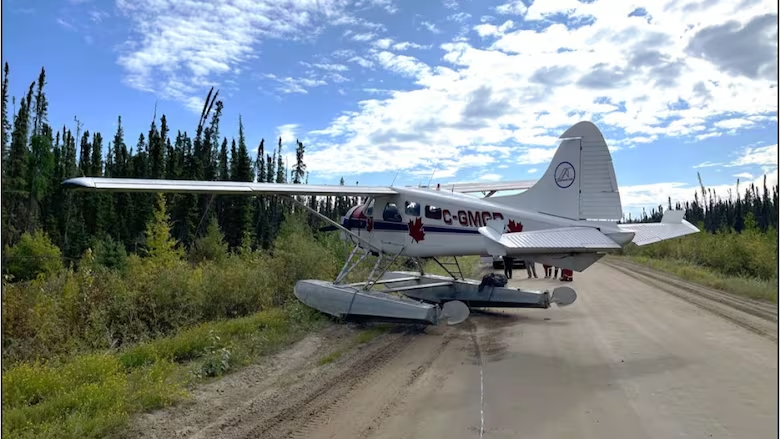Inaccurate fuel reading to blame for 2024 Fort Simpson emergency landing, TSB finds

An inaccurate fuel-reading was the cause of a floatplane’s emergency landing near Fort Simpson, N.W.T. in 2024, according to an investigation from the Transportation Safety Board of Canada (TSB) released Tuesday.
On Aug. 29, 2024, an Air Simpson Beaver floatplane made an emergency landing on Highway 1 near Martin River Bridge, about 15 kilometres from Fort Simpson. The plane was returning from picking up two passengers and gear from Rabbitkettle Lake when the plane ran out of fuel.
None of the three people on board sustained injuries, and there was only minor damage to the aircraft on the bottom of its floats and to one of its wings from some shrubs.
The TSB’s report describes the pilot fuelling the plane before the trip. The fuel pump didn’t have a fuel metre to indicate how much fuel had been added to the aircraft, and the pilot relied on experience to establish how much he should fill the fuel tanks.
The pilot filled each of the fuel tanks until they appeared full but a swell in the water gave the appearance of a tank being full.
He couldn’t remember if he checked the plane’s fuel gauges before taking off.
After arriving at Rabbitkettle Lake, the pilot thought the plane was still sufficiently fuelled to make it back to Fort Simpson and opted not to refuel. On the return trip, fuel tanks were emptying sooner than the pilot expected but he wasn’t concerned. He reasoned that between the extra weight from the gear and passengers and using a higher setting to quicken a climb to higher altitude, the plane might burn more fuel. But he figured based on previous flight experience that there was still enough to return to Fort Simpson with some still in the reserve.
Shortly before the destination, the fuel tanks showed empty, and the pilot performed the emergency landing on Highway 1. Rescue personnel from Fort Simpson arrived on the scene about 20 minutes later.
Following the incident, the report indicates that Simpson Air added a fuel metre to its fuelling truck, created a new checklist for the Beaver aircraft with additional fuel checks and reminded pilots of the importance of ensuring sufficient fuel and continuing to monitor fuel levels. The company also increased its requirements on fuel reserves from 30-minutes of additional fuel to 45-minutes.
It’s vital for pilots to have a clear understanding of their actual fuel amounts versus what’s required, the TSB wrote. In a floatplane, that means using fuel metres, waiting for calm water, cross-checking fuel gauges and re-fuelling during stops.
Related stories from around the North:
Canada: Northern airlines say feds should intervene if they want lower prices for the North, CBC North
Finland: Record December passenger numbers for airports in Arctic Finland, Eye on the Arctic
Greenland: New Copenhagen-Kangerlussuaq flight aims to boost Greenland tourism, Eye on the Arctic
Norway: Air France launches flights to three destinations above the Arctic Circle, The Independent Barents Observer
Sweden: Northern Scandinavia to pioneer commercial flights with electric planes, Radio Sweden



